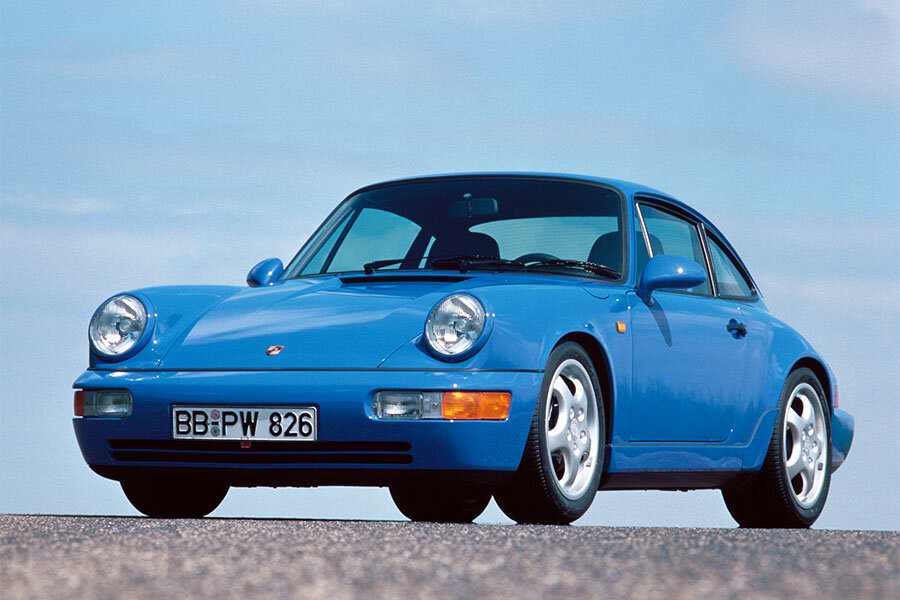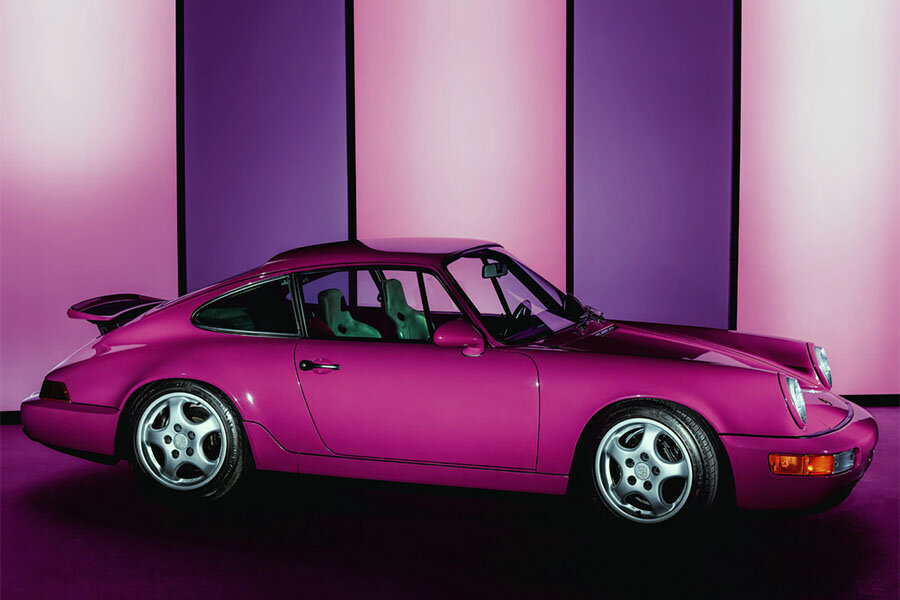Guide: Porsche 911 3.6 Carrera RS (964) - a Historical & Technical Appraisal
/BACKGROUND
Porsche’s first 911 Carrera RS arrived in late 1972. It was created to homologate a Group 4 racing 911 which meant 500 Carrera RS road cars had to be produced within a twelve month period.
As it turned out, demand for the powerful stripped out special was such that Porsche ultimately sold over two-and-a-half times as many as they needed to.
The 2.7-litre Carrera RS was replaced by a three-litre evolution model for the 1974 season but only a tiny number of these cars were built in comparison to the original.
From 1976, the turbocharged 930 served as the basis for Porsche’s GT racing cars.
The 930 proved so popular that Porsche decided to make it a permanent fixture in their model line up. However, this was no stripped out lightweight. Instead, the 930 was a luxury flagship that offered supercar-rivalling performance with the kind of practicality the 911 had become renowned for.
In 1987, Porsche did finally introduce an heir true to the original seventies Carrera RS; the Carrera Club Sport built until 1989 was a marketing spin off rather than a homologation special created with racing in mind.
Meanwhile, back in 1986, Porsche had initiated the Carrera Cup Germany, a one-make series organised for specially prepared 944 Turbos. The Carrera Cup France joined the fray from 1987 and, over the next few years, these Porsche-only contests grew in popularity and stature.
For 1990, the new 964 Carrera 2 was used for the Carrera Cup series. Specially prepared Carrera 2 Coupes were uprated with improved suspension and brakes, a high output engine and stripped out interiors with added safety gear.
The Cup car’s extensive list of modifications then formed the basis for Porsche’s latest homologation special: the 964 Carrera RS.
Presented at the Geneva Motor Show in March 1991, production began five months later for the 1992 model year.
The 964 Carrera RS was created to qualify a lighter, more powerful 911 for the N/GT class of racing which demanded 1000 cars had to be built within a twelve month period.
Unfortunately, owing to the absence of certain safety equipment, this latest Carrera RS was not originally available in the USA.
CHASSIS
Each Carrera RS began with a seam-welded bodyshell that featured a reinforced floor along with reinforced mounts for the rear suspension, transmission and anti-roll bars.
To save weight, the underseal was left off which resulted in the normal ten year anti-corrosion warranty being reduced to just three.
As the Carrera RS was rear wheel drive only, sufficient space was freed up for a long-range 92-litre fuel tank instead of the standard 77-litre item fitted to other 964s.
Power steering was absent on left-hand drive derivatives but standard on right-hand drive examples.
Compared to earlier iterations of the 911, the 964 had ushered in a revised suspension arrangement that did away with torsion bars in favour of coil sprung dampers. A MacPherson strut arrangement was retained at the front while the back end used the cast-aluminium semi-trailing arms from the 930.
Suspension on the Carrera RS was significantly uprated over the standard variant.
It came with stiffer progressive rate springs, Bilstein instead of Boge dampers, aluminum instead of steel hubs and a cross-brace fitted between the front shock absorber top mounts. There were also ball joints for the upper spring strut mounts, hard rubber lower control arm bushings and modified trailing arm mounts at the rear.
Ride-height was dropped by 50mm at the front and 40mm rear. Camber was also increased.
Adjustable anti-roll bars were fitted at both ends. The front went from 20mm to 24mm and was five-way adjustable. The rear was reduced from 20mm down to 18mm and was three-way adjustable.
The brakes also came in for significant attention with cross-drilled and ventilated discs now fitted all round. The front system was sourced from the Turbo. Disc size went from 298mm to 322mm and calipers with bigger pistons were installed. The rear discs stayed at 299mm (as per the standard Carrera and Turbo) but the pistons were modified to accept the thinner cross drilled and ventilated discs from the Carrera Cup racing cars.
Additionally, the ABS was re-tuned to provide better recovery during hard use and a hydraulic instead of vacuum servo was fitted along with a bigger master cylinder.
New magnesium Cup Design wheels replaced the standard alloy Club Sport rims. The fronts went from 6 x 16-inches to 7.5 x 17-inches. The rears went from 8 x 16-inches to 9 x 17-inches. Low profile rubber was supplied by Dunlop and Pirelli.
ENGINE / TRANSMISSION
In the engine bay was a more powerful version of the twin spark all-alloy Flat 6 found in the normal 964. Like the standard car, it ran single overhead camshafts, two valves per cylinder and dry-sump lubrication.
The Type M64/03 unit fitted to the Carrera RS came with matched pistons and cylinders.
Re-mapped Bosch Motronic engine management was fitted along with a single cooling fan drive and lightweight flywheel (that saved 7kg).
The engine was located on solid rubber instead of hydraulic mounts and required 98 RON fuel instead of the 95 RON fuel that the normal engine could run on.
Displacement was kept at 3600cc thanks to a bore and stroke of 100mm and 76.4mm respectively. Similarly, the compression ratio stayed at 11.3:1.
Peak output went from 250bhp to 260bhp at an unchanged 6100rpm and from 229lb-ft to 240lb-ft at an unchanged 4800rpm.
Instead of the normal G50/03 gearbox, a G50/10 unit was fitted to the Carrera RS. It was another five-speed manual but came with a short shift lever, hard rubber mounts, new ratios on first and second and modified steel synchronisers for quicker shifts.
Transmission was via a twin-plate clutch and the same limited-slip differential as fitted to the turbocharged 965.
BODYWORK
Externally, all four wheelarches were subtly flared to accommodate the wider wheels and tyres.
To save weight, the steel front lid was switched to aluminium, no door protection beams were fitted and thinner side and rear glass was installed (3mm instead of 4.7mm).
Manual instead of electric mirrors were used.
A lightweight rear bumper was also produced that featured lights either side of the licence plate (instead of above it).
A new Carrera RS script was mounted on the engine cover.
INTERIOR
While the exterior changes were comparatively modest, that was certainly not the case inside; Porsche stripped away much of the normal equipment and replaced it with an array of simplified parts.
To save weight, the rear seats were deleted and an RS logo was embroidered on this newly carpeted section.
Thinner carpet was used throughout and most of the sound insulation was absent (including from the engine bay).
The front seats were switched to fibreglass Recaro buckets that offered manual fore / aft adjustment only. The seats were trimmed with leather and the centre panels were normally upholstered with four different coloured inserts.
Body coloured seatbelts were often fitted and mounting points for six-point harnesses were always plumbed in.
The standard door panels with their armrests and storage bins were junked in favour of lightweight parts with simple handles and fabric looped door pull chords in one of four colours (red, blue, yellow or black).
Porsche also deleted the power-operated windows and mirrors, the central locking system, the alarm, the interior light and even the passenger sun visor. Gone too were the airbags.
Provision was made for a two speaker audio system.
The four-spoke steering wheel was uniquey embossed with an RS insignia.
Although the rear window retained elements for heating, they were not activated.
As a result of the greatly reduced electrical requirement, a 36 AH instead of 72 AH alternator was fitted along with a simplified wiring loom and lightweight battery.
In the trunk was a reduced carpet set that only covered the spare wheel, a simplified cover for the front bulkhead, a small one-litre windscreen washer bottle and the lightweight 36 AH battery with cut-out switch just above.
WEIGHT / PERFORMANCE
Compared to a standard Carrera 2 Coupe, the Carrera RS was 100kg lighter (1250kg).
Top speed went from from 158mph to 162mph and the 0-62mph time dropped from 5.8 seconds to 5.4 seconds.
OPTIONS
Optional extras included a basic stereo, a steering wheel with extended hub, six-point Schroth harnesses and model designation deletion. Further customisation could be carried out by special request at Porsche’s Exclusive department.
Customers buying a Carrera RS could choose to upgrade their standard car with one of three trim packages.
M001 CUP
Option code M001 was for a track only Cup racing car (covered separately).
M002 TOURING
Option code M002 was for Touring specification which re-instated many of the fixtures and fittings absent from the pared down standard Carrera RS.
The bodyshell was sound proofed and undersealed which meant the normal ten year anti-corrosion warranty applied.
Inside, Porsche fitted standard door panels and the Sports seats that were an option on the regular models (albeit fitted with custom multi-coloured centres).
Electric windows, electric mirrors, central locking, an alarm, heated rear window and a proper stereo were also installed which meant the 72 AH alternator, heavier wiring loom and standard-sized battery returned.
There were, however, still no airbags.
Under the front lid, M002 Touring variants came with standard trunk carpet, a full size 7.4-litre washer bottle and no cut-out switch.
As a result of all this additional equipment, these cars were around 100kg heavier than the standard Carrera RS.
At further cost, M002 Touring buyers could also request electric and heated seats, power steering, a sunroof, headlight washers and air-conditioning.
M003 COMPETITION N/GT
Option code M003 was for Competition specification (sometimes referred to as N/GT) which essentially resulted in a road legal racing car.
All the interior upholstery (carpet, headliner and A/B pillar trim) was absent and the cockpit was painted to match the exterior.
Plywood footboards were installed along with a Matter roll cage, six-point Schroth harnesses, a cable-activated master switch and onboard fire extinguisher. The DME control box was moved from underneath the driver’s seat to behind it.
20 M003 Competition variants were also built with leather seats and a carpeted interior.
PRODUCTION
The 964 Carrera RS was produced for twelve months between the summer of 1991 and 1992.
During this time, 2282 were manufactured (ignoring the M001 Cup variant).
Of these, 1916 were built to standard specification (72 of which were right-hand drive).
76 were completed to M002 Touring specification (with eleven in right-hand drive).
The remaining 290 were M003 Competition derivatives (all of which are believed to have been left-hand drive).
Homologation was approved on March 2nd 1992.
Privateers subsequently went on to race the Carrera RS in domestic championships around Europe, the BPR Global GT series and the 24 Hour races at Le Mans, Spa and the Nurburgring.
Text copyright: Supercar Nostalgia
Photo copyright: Porsche - https://www.porsche.com



































